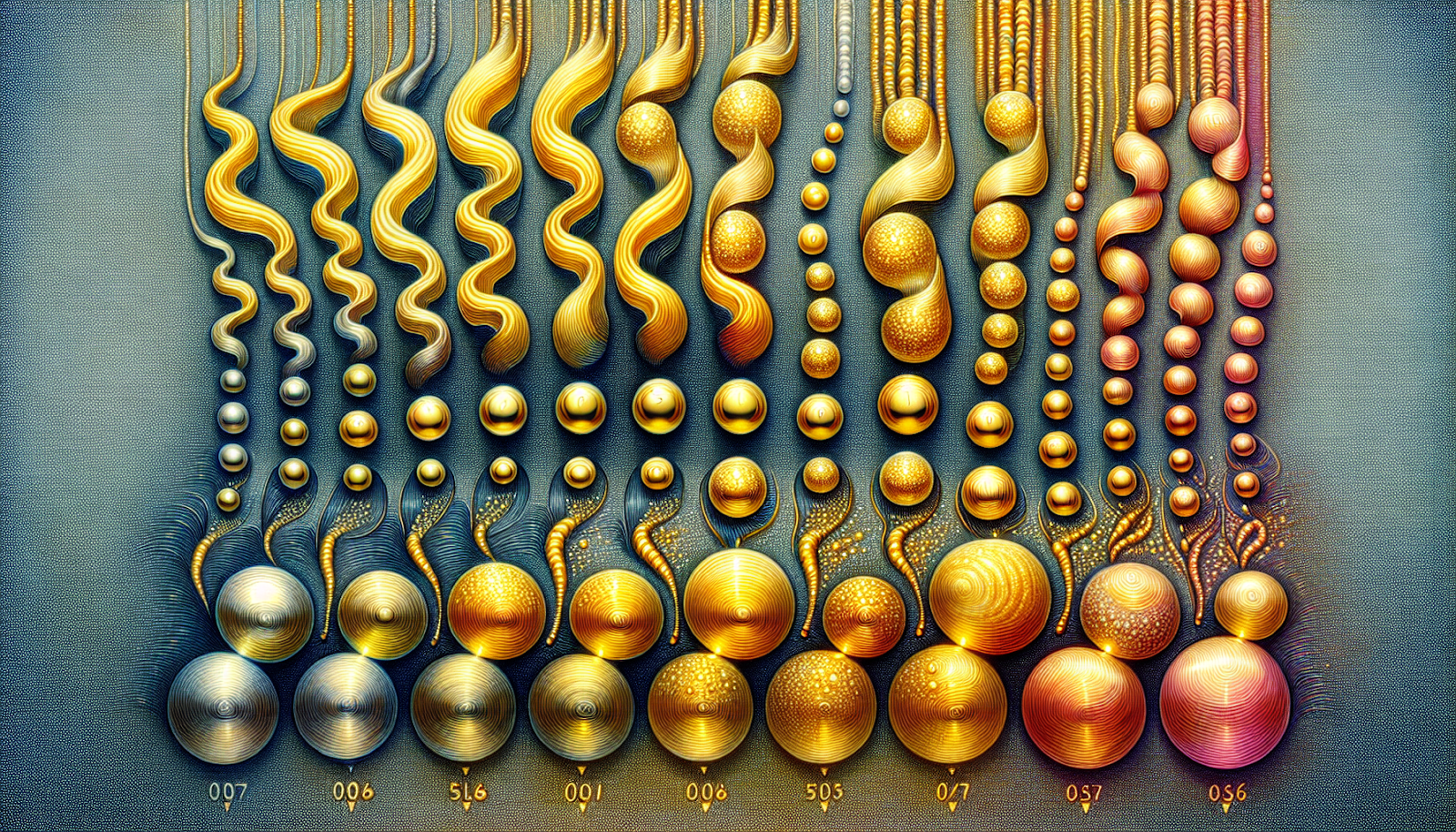
916 Gold vs 999 Gold: The Ultimate Guide to Understanding 916 and 999 gold Jewellery pieces
When comparing 916 gold vs 999 gold, each serves a specific purpose in jewelry making and investment. Understanding their differences in purity and the implications for durability and value is key to making the right choice for your needs.
In This content, we offers a look into how these two gold types stack up against each other, ensuring you’re equipped with the knowledge to decide which “916 gold vs 999 gold” option is right for you.
Key Takeaways
Gold purity is measured in karats or millesimal fineness, with karats indicating the gold content ratio in an alloy and millesimal fineness representing purity in parts per thousand.
916 gold (22 karat) contains 91.6% gold, offering a balance between high gold content and strength for daily wear, while 999 gold has 99.9% purity, highly valued for investment but less durable for everyday jewelry.
Choosing between 916 and 999 gold is determined by personal needs, including budget, skin sensitivities, aesthetic preferences, jewelry style, and investment goals, each offering distinct benefits and considerations for consumers.
1.0 Gold Purity Basics: Karats and Millesimal Fineness
When you step into the radiant world of gold jewellery, you’ll quickly realize not all gold shines the same. The purity of a gold jewellery piece is the key to its value, appearance, and even how it feels against your skin.
But how is gold purity measured? It’s a dance of numbers and terms, with karats and millesimal fineness leading the waltz. These measures are critical in the gold jewellery trade, as they directly influence gold prices and the quality of the pieces.
Understanding the difference between karats and millesimal fineness is like learning a new language in the realm of gold. While karats reveal the gold content ratio in an alloy, millesimal fineness speaks in parts per thousand, painting a picture of how much gold is really in that ring on your finger.
With these metrics, we navigate the waters of the gold market, from the purest gold bar to the intricate gold beads adorning many gold jewellery pieces. There are many of the lustrous allure of gold bars we can find out.
1.1 Karats: Gold Content Ratio
The karat number is the first clue to a gold piece’s value. Think of the karat system as a pie chart for your gold: each karat represents 1/24 part, or 4.1667 percent, of the whole. So, when you’re eyeing that stunning white gold necklace, the karat number tells you just how much gold is in the mix. The higher the number, the more gold, and of course, the greater the enchantment—and often, the price.
But there’s more to this story. If you’re curious about the exact gold content, a little math will reveal the secret. Divide the karat number by 24, multiply by 100, and voilà—you’ve unlocked the percentage of pure gold in your cherished piece. This is why the karat rating is so revered: it’s a transparent measure that allows you to compare different gold purity levels with confidence when buying gold.
1.2 Millesimal Fineness: Parts per Thousand
While karats offer a familiar measure, millesimal fineness brings precision to the table. With this system, gold’s purity is told in a tale of a thousand parts. It’s the gold rating for those who appreciate the finer details, providing an exact count of how many parts in a thousand are pure gold. And when it comes to 999 gold, you’re looking at the purest form of gold, boasting a staggering 99.9% purity.
This level of purity isn’t just about bragging rights; it’s about the incredible monetary value locked within each gram of this nearly perfect metal. With minimal additional elements, 999 gold stands at the pinnacle of purity, offering an investment piece as close to gold’s pure state as one can hold. It’s a prized possession for those who seek the ultimate in gold purity levels.
2.0 The Differences Between 916 and 999 Gold
Transitioning from the basics of gold purity, let’s delve into the heart of our guide: the distinction between 916 gold and 999 gold. These numbers aren’t just arbitrary; they’re a testament to the level of mastery involved in creating gold pieces that not only captivate the eye but also stand the test of time.
The “916” and “vs 999 gold” debate is about more than just numbers; it’s about choosing a gold that resonates with your lifestyle and values.
At their core, 916 gold and 999 gold are defined by their purity levels. But there’s a world of difference between the two. While both are highly valued in the gold jewellery trade, they cater to different tastes, needs, and occasions.
The question isn’t just about which is better—it’s about which is better for you. And as gold prices fluctuate, understanding these differences becomes even more crucial for anyone considering buying gold or investing in it. I recommend that you must have a better understanding of the Malaysia gold bar Investment guide before doing anything.
2.1 Gold Purity Levels: 91.6% vs 99.9%
Purity is the essence of gold’s allure, and when we talk about 916 gold vs 999, we’re looking at two distinct purity levels. The 91.6% purity of 916 gold strikes a harmonious balance—it’s not just about the high gold content, but also about the strength imparted by the other metals in the alloy.
This not-so-hidden 8.4% is the artisan’s canvas, allowing a little more creativity in crafting pieces that endure. It’s a gold that understands the daily rigors of life, making it the next best gold rating after the purest form of gold.
On the other end of the spectrum, 999 gold represents purity in its most elevated form. With a gold content that nearly touches the heavens at 99.9%, it’s considered pure gold. However, this purity comes with a caveat: it’s highly malleable, which translates to a metal that’s softer and more impressionable.
For those who prefer their gold in its most untainted form, 999 gold is an unadulterated expression of luxury and a common purity level in 9999 investment gold bars reserved for the most special of occasions.
2.2 Durability and Practicality
While purity captivates the mind, durability wins the heart, especially when it comes to items we cherish every day. This is where 916 gold truly shines. Its robust composition makes it a fortress against the wear and tear of daily life, ensuring that your treasured pieces retain their beauty and integrity over time.
This is why 916 gold is often the metal of choice for engagement rings and other jewelry that accompanies us on life’s journey.
For those who value longevity and resilience in their jewelry, 916 gold offers a reliable choice. It’s a metal that allows for a striking statement, featuring classic and contemporary designs that can complement any outfit effortlessly.
Conversely, the softer nature of 999 gold, while offering a pure and classic gold aesthetic, requires a gentler touch and may not be the best companion for the hustle of everyday life. It’s a precious metal more often found in the physical showrooms of investors than in the jewelry boxes of active individuals.
2.3 Color Variations: Yellow, Rose, and White Gold
Gold’s beauty isn’t just in its luster; it’s also in its versatility. With 916 gold, we find a palette of possibilities, from the rich yellow hue that has adorned empires to the romantic blush of rose gold and the modern sophistication of white gold.
It’s a gold that understands our desire to stand out and to find rose gold or white gold jewellery that reflects our personality. This ability to produce colours is a testament to the metal’s adaptability and a key reason why many gold jewellery pieces in our collections are made from 916 gold.
In contrast, 999 gold is the ode to tradition, the gold that our ancestors would recognize. It’s the metal that brings abundance to auspicious occasions and is the hot favourite for those who cherish the classic gold aesthetic.
While it may not offer the same breadth of color as 916 gold, it holds a timeless appeal that transcends fashion. For those who seek a pure and traditional symbol of luxury, 999 gold is the undeniable choice.
3.0 Choosing the Right Gold for Your Needs
As we explore the myriad facets of gold, it becomes clear that choosing the right type for your needs is a personal journey. The decision between 916 gold vs 999 gold is influenced by a tapestry of factors, each as unique as the individual making the choice.
Whether you prefer jewellery that aligns with your budget, prioritizes your skin’s health, or satisfies your aesthetic taste, the choice of gold is a delicate balance between practicality and personal preference.
When it comes to the gold jewellery trade, not all gold is created equal. The nuanced differences between 916 gold and 999 gold mean that each type serves a different purpose and appeals to different people.
Aesthetic preferences, lifestyle, and even the very occasion for which the gold piece is intended all play a role in determining the most suitable type of gold. So, let’s weigh these considerations and find the gold that not only glitters but also resonates with who we are and what we need.
3.1 Budget Considerations
Your budget is the compass that guides your journey through the world of gold. When deciding between 916 gold vs 999, it’s essential to understand that the latter stands as a beacon of incredible monetary value due to its higher purity level. 999 gold, often considered pure gold, commands a higher price per gram, a reflection of its nearly unalloyed state and the value it brings as a valuable asset.
On the other hand, the allure of 916 gold lies not just in its beauty or durability, but also in its affordability. This gold strikes a chord with those who seek the golden touch without the premium price tag. While the price difference might seem minute at a glance, it’s a significant factor when buying gold in larger quantities or more substantial pieces.
For many, 916 gold anklet represents an accessible entry into the world of fine gold without compromising on quality or beauty.
3.2 Skin Sensitivity and Allergies
For those with the curse of skin sensitivity, the quest for the perfect gold can be fraught with peril. But there is a golden light at the end of the tunnel: 999 gold. With its minimal alloy content, this gold is the gentlest of touches against the skin, reducing the risk of allergic reactions and making it suitable for even the most sensitive of wearers.
It’s a pure embrace, free from irritants like nickel that can mar the joy of wearing gold.
While 916 gold offers a more robust option for jewelry, its alloy composition may include metals that provoke skin allergies in some individuals.
It’s a reminder that the most precious gold is the one that allows you to shine without discomfort. In this regard, 999 gold holds the crown, offering an extremely soft touch that respects the delicate nature of your skin.
3.3 Aesthetic Preferences and Jewelry Styles
The gold you choose is an extension of your personality, a reflection of your style and taste. With 916 gold, the jewelry world is your oyster, offering an exquisite variety of designs that can range from elaborate traditional motifs to sleek, modern artistry.
This flexibility is a boon for those who prefer sk jewellery that makes a statement, that speaks to their unique identity and complements their wardrobe.
For others, the minimalist allure of 999 gold, with its classic and contemporary designs, may be the perfect fit. This gold’s purity is not only a testament to its value but also a reflection of a style that is both timeless and elegant.
Whether it’s a simple band that captures the essence of love on a wedding day or an auspicious pendant that represents wealth and prosperity, 999 gold is a traditional symbol that resonates with many. It’s a choice that’s less about the flash and more about the enduring glow of pure gold.
4.0 Caring for Your Gold Jewelry
Your gold jewelry is more than just a decorative element; it’s an investment in beauty that demands care and attention. Whether it’s a 916 gold ring or a 999 gold bar, each piece requires a nurturing touch to maintain its luster and value. Protecting your gold from harsh sunlight and corrosive chemicals ensures that its brilliance is not dulled by the elements.
And when it comes to cleaning, a gentle approach with lukewarm water and mild soap can work wonders, preserving the intricate jewellery designs that make your pieces unique.
Safe storage is equally important. Just as you wouldn’t throw precious gold beads into a drawer with other metal items, your gold deserves a dedicated space where it can rest without fear of scratches or damage.
Tarnish-resistant pouches and padded jewelry boxes are sanctuaries for your treasures, keeping them safe and radiant for future generations. And don’t forget routine maintenance—especially for 916 gold pieces, which may require more frequent care due to their alloy composition. A professional cleaning every six months can keep your gold shining like new.
5.0 Investing in Gold: 916 vs 999 Gold
When it comes to investing in gold, the choice between 916 and 999 gold can shape the future of your portfolio.
Here are the key differences between 916 and 999 gold:
999 gold has a near absence of impurities, making it the highest purity gold available.
916 gold, also known as 22 karat gold, contains 91.6% gold and 8.4% other metals.
999 gold is often selected for its high level of purity and the premium it commands in the market.
Holding a 999 gold bar is like grasping a piece of financial security, making it a highly valued choice for investors.
Consider these factors when deciding which type of gold to invest in.
However, 916 gold’s more accessible price point opens the doors to investment for a broader audience. While its purity may not reach the lofty heights of 999 gold, it still represents a solid investment, and its more affordable nature means that it can be a valuable asset for those looking to diversify their holdings.
Whether you’re buying gold for personal enjoyment or as an gold investment, understanding the nuances between 916 gold vs 999 gold can help you make an informed decision that aligns with your financial goals.
| 916 Gold (22 Karat) | 999 Gold (24 Karat) | |
| Purity | Comprises 91.6% gold with 8.4% other metals. | Contains 99.9% gold, making it the purest form of gold available. |
| Durability | Offers a balance between high gold content and strength for daily wear. | Softer and more impressionable, less suitable for jewelry that will experience daily wear and tear. |
| Color Variations | Available in yellow, rose, and white gold, providing options for different aesthetic preferences. | Typically found in a classic yellow gold color due to its high purity. |
| Jewelry Suitability | Ideal for everyday jewelry like engagement rings due to its robustness. | Often used for special occasions or investment rather than daily wear. |
| Price | More affordable than 999 gold, making it a popular choice for those on a budget. | Commands a higher market price due to its purity. |
| Skin Sensitivity | The additional metals may cause allergic reactions in some individuals. | Hypoallergenic, posing a minimal risk of skin irritation. |
| Investment | Requires routine care and professional cleaning to maintain its appearance. | Highly valued by investors for its purity and is a common choice for gold bars and coins. |
| Maintance | Requires routine care and professional cleaning to maintain its appearance. | Requires careful handling, but less frequent maintenance due to its purity. |
6.0 Summary
As we draw this golden guide to a close, we reflect on the journey through the nuances of 916 gold and 999 gold. We’ve explored the importance of understanding gold purity and how it affects everything from the durability and aesthetic of jewelry to the value of an investment.
We’ve seen how each type of gold serves a different purpose and caters to individual preferences, from the allure of 916 gold’s diverse styles and colors to the pure, classic beauty of 999 gold.
Choosing between 916 and 999 gold is a delicate dance of personal taste, budget considerations, and practical needs. Whether you’re drawn to the rich tradition of 999 gold or the versatile beauty of 916 gold, remember that the true worth of gold lies not only in its price but in the joy and security it brings to your life.
May this guide be a beacon as you navigate the glittering seas of gold, helping you to find the treasure that best suits your heart’s desires.
7.0 Frequently Asked Questions
a. What is the primary difference between 916 and 999 gold?
The primary difference between 916 and 999 gold is their purity levels. 916 gold has a purity of 91.6%, while 999 gold is considered pure with a purity of 99.9%. This translates to 91.6% pure gold and 8.4% other metals for 916 gold, and almost no other metals for 999 gold.
b. For jewelry making, is 916 or 999 gold better?
For jewelry making, 916 gold is better if you prioritize durability and wearability in your designs, while 999 gold is purer but softer and may be less suitable for everyday wear.
c. How should I care for my gold jewelry to maintain its appearance?
To maintain the appearance of your gold jewelry, protect it from sunlight and chemicals, clean it gently, store it in tarnish-resistant pouches or padded boxes, and have it professionally cleaned every six
--------------------------------------------------------------------------------------------------------------------------------
Keep learning and stay informed to make the most of your investments.
Disclaimer: The information provided in this document is for educational and informational purposes only and should not be construed as financial advice. Always consult with a professional financial advisor before making any investment decisions.
months. These steps will help preserve its luster and ensure its settings remain secure.







